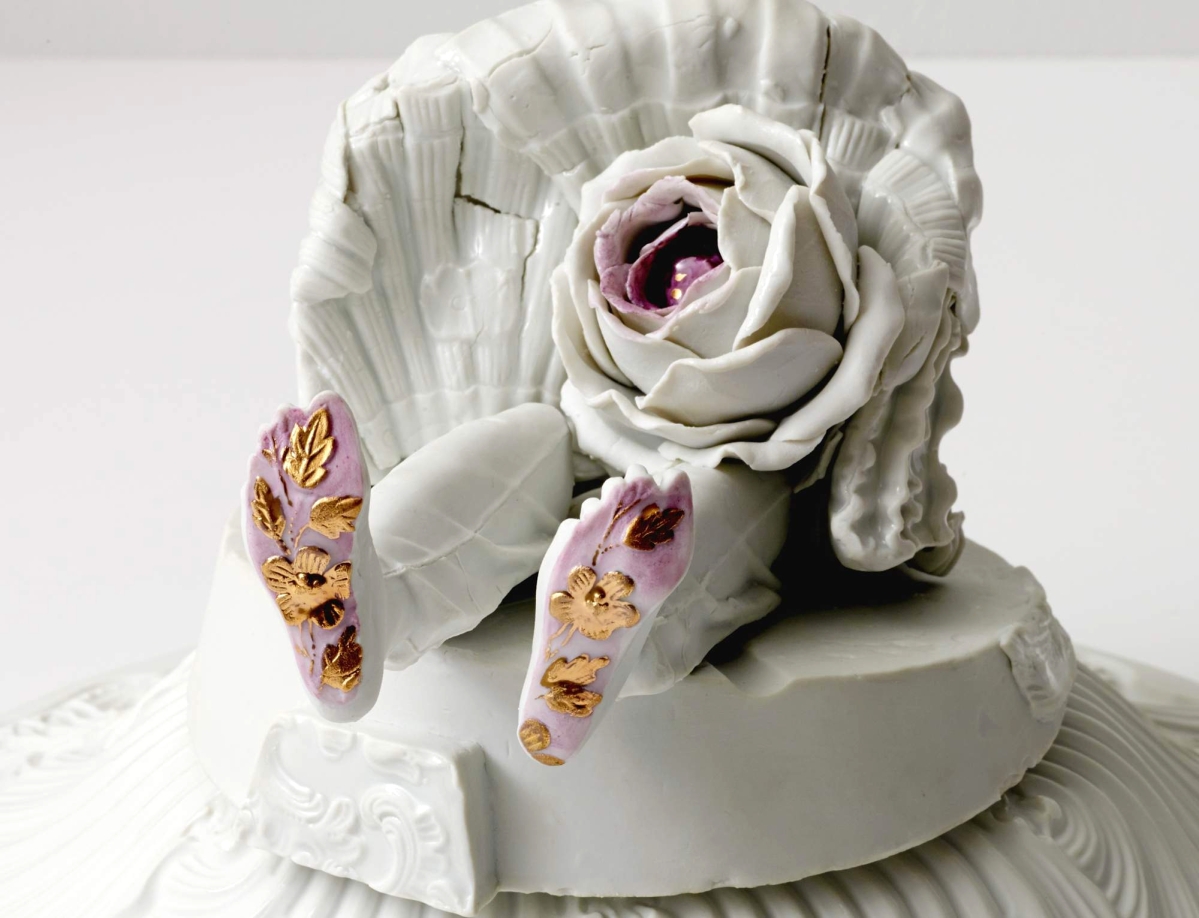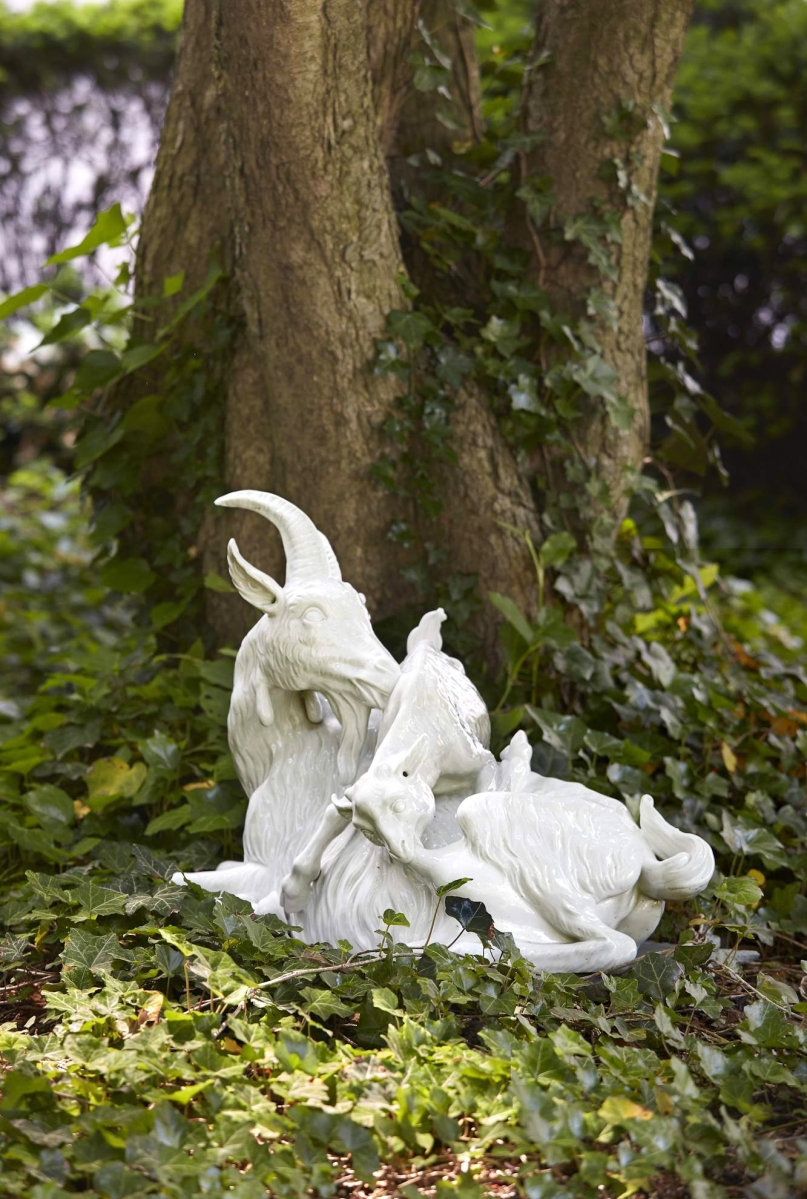
“Dancing Girl with Two Right Feet” by Arlene Shechet, 2012, glazed hard-paste porcelain, gold, 10-5/8 inches high. Unique. Private collection. —Jason Wyche photo
NEW YORK CITY – The Frick opened an exhibition from Arlene Shechet and the Arnhold Collection titled “Porcelain, No Simple Matter” last May. On view until April 2, this special exhibition explores the complex history of making, collecting and displaying porcelain.
A publication with the same title, Porcelain, No Simple Matter: Arlene Shechet and the Arnhold Collection has been published to accompany the exhibition; this beautifully illustrated booklet includes installation photographs, a complete exhibition checklist and a conversation between exhibition organizer Charlotte Vignon, the Frick’s curator of decorative arts; Henry Arnhold, the renowned collector of early Eighteenth Century Meissen porcelain; and New York-based artist Arlene Shechet, who designed the exhibition.

Cruet and mustard pot, hard-paste porcelain, 1737–39,modeled by Johann Joachim Kändler, 1737, cruet, 7 inches high; mustard pot, 7½ inches high. Private collection. —Maggie Nimkin photo
The show integrates 16 porcelain sculptures created by Shechet at the Meissen manufactory in Dresden during a two-year residency in 2012-13 into a selection of about 100 objects from Henry Arnhold’s private collection, many of which are part of a promised gift made to the Frick in 2011.
Shechet’s inventive installation richly extends the context of both the Eighteenth Century porcelain pieces and her work. Her “artist’s eye” perspective eschews the typical chronological or thematic order of most installations in favor of a personal approach that opens an intriguing visual and technical dialogue between the contemporary and the historical. Shechet’s installation is inspired by the domestic setting of the Frick’s galleries, which are characterized by a combination of objects, textures, colors and materials. Shechet turned to objects from the Frick’s permanent collection when designing the display cases, taking as her inspiration, for example, the Eighteenth Century French table by André-Charles Boulle that is currently in the Living Hall. Likewise, the green damask behind the exhibition’s display cases evokes the museum’s fabric-covered walls.
The exhibition’s location in the Portico Gallery, overlooking the museum’s historic Fifth Avenue Garden, reflects Shechet’s wish to extend the exhibition into the garden while simultaneously bringing the natural world indoors. For this reason, Plexiglas was chosen for the two pedestal tables near the floor-to-ceiling windows in order to offer an unobstructed view of the garden.
The theme of the exhibition also derives from its location, with the featured pieces selected for their evocations and depictions of nature, an important source of inspiration for artists working at the Meissen factory, including Shechet. The integration of Shechet’s work with porcelain from Arnhold’s collection creates a kind of tableau vivant in which the objects – figures, cups, teapots and vases – seem to come to life, a direct reference to the Eighteenth Century European concept of animating inanimate objects.

Nanny-Goat with Kid after a model by Johann Joachim Kändler from 1732, Twentieth Century, hard-paste porcelain, 19½ inches high. Private collection.
—Michael Bodycomb photo
The display also references late Seventeenth- and Eighteenth Century European gardens that invited contemplation of art and nature, as well as contemporaneous “porcelain rooms” in which walls were covered with hundreds of pieces of porcelain, often arranged by color. As in these historical settings, surprise and delight are at the core of the installation; look for porcelain birds mounted overhead in the Portico’s rotunda and large Meissen animals outside, their stark white a dramatic contrast to the greenery of the garden.
Long admired for their masterfully modeled shapes and gemlike glazes, Meissen porcelain offers a window into the early years of manufacturing porcelain in the West and celebrates a fascinating chapter in the history of the ceramic medium. Although the formula for manufacturing true porcelain had been developed in China by the Sixth Century, it remained a consuming mystery in the West until its discovery in 1708 under the patronage of Augustus I (1670-1733), elector of Saxony and king of Poland. In 1710, the king established a royal manufactory outside of Dresden in the town of Meissen, and the porcelain created there has been known by that name ever since. Early Meissen porcelain was at the forefront of the European ceramic industry until the ascendancy of the Royal Sèvres Manufactory in France in the 1750s.
Shechet’s diverse body of work draws on balance, breath, humor and the creative potential of failure. Corporeal yet transcendent, her work explores the friction when categories start to slip, giving way to subliminal play. She is the subject of much critical acclaim and is the recipient of many awards, including a John S. Guggenheim Foundation Fellowship Award in 2004, a Joan Mitchell Foundation Painters and Sculptors Grant in 2010 and an American Arts and Letters Award in 2011. She is the 2016 recipient of the CAA Artist Award for Distinguished Body of Work.
The Frick Collection is at 1 East 70th Street. For further information, www.frick.org or 212-288-0700.













